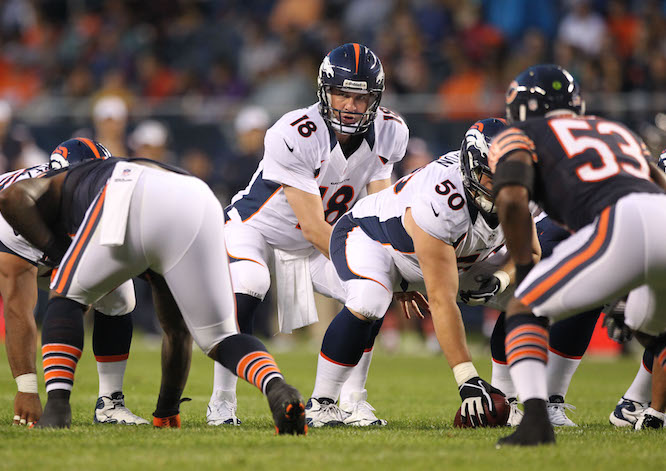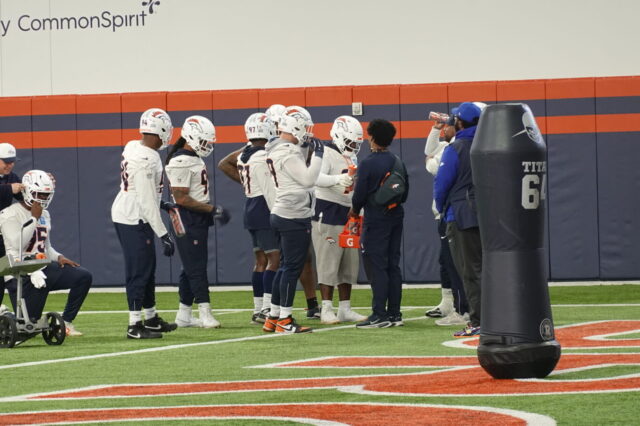The ball has been snapped on the 2015 edition of Denver Broncos training camp and head coach Gary Kubaik and general manager John Elway have made it very apparent that the team’s goal is a championship. After three consecutive disappointing playoff exits, the new coaching regime led by Kubiak has extremely high expectations and a narrow window of opportunity; though he’s under contract through 2016, speculation remains rampant that this could be Peyton Manning’s last season in the NFL. Elway would love nothing more than to send Manning off into the sunset with a Super Bowl victory in hand, just like he enjoyed with Kubiak as his offensive coordinator in his final season.
But in order for that to happen, much has to be accomplished between now and the start of the season – much less during the season. First and foremost, Denver must solidify some key roles in the trenches. Then, Manning must prove he can adapt to a new offensive scheme. And finally, the Broncos will need to develop several new offensive playmakers as they look to replace significant offensive production that was lost in the offseason. If Denver hopes to dethrone New England and possibly get redemption against Seattle (or any other NFC juggernaut, say Green Bay), each of these three things must fall in line. And it all begins at camp.
The biggest issue, literally and figuratively, that the Broncos will be addressing at training camp is shoring up both sides of the line. Finding bona fide contributors at key positions is priority numero uno this year.
On the defensive side of the ball, the Broncos interior line was officially thrown into major flux last week when it was announced that defensive end Derek Wolfe will be suspended for the first four games of the season because of a PED violation. Opposite Wolfe, Malik Jackson led the d-line with 42 combined tackles, compared to Wolfe’s 35. Veteran Antonio Smith was signed in the offseason and is currently behind Jackson on cbssports.com’s depth chart, but that could change with Wolfe’s suspension. Smith faced serious allegations of child sexual abuse and did not participate in minicamp or OTAs as a result. Although charges have not yet been filed in the case, there is no doubt a cloud hanging over his status with the team. Meanwhile, Kenny Anunike and Vance Walker received praise from Kubiak during the Q& A session of the annual media BBQ, a clear sign that Wolfe’s replacement is by no means set.
The nose tackle position was already in question thanks to the departure of Terrance Knighton, leaving a large productivity, not to mention leadership, hole to fill. Knighton added 30 combined tackles and two sacks to the interior d-line’s numbers. Denver was second in the league in rushing yards per game, very much a testament to the work of the interior linemen. Sylvester Williams will very likely get the nod at nose tackle, but whether or not he can clog the middle as effectively as “Pot Roast” did will be the real determining factor in how close the defensive line can come to duplicating last year’s success. The Broncos have one of the best secondaries and linebacking corps in the league, but a soft underbelly could derail a season with Super Bowl aspirations.
Denver’s issues on the offensive line have been documented ad nauseam ever since left tackle Ryan Clady suffered a season-ending ACL tear during offseason activities. But the questions surrounding the o-line were surfacing even before Clady went down for the year. Kubiak’s arrival brought with it a change in offensive scheme, moving back to the zone-blocking system Kubiak learned and employed during his stint as a coordinator in Denver and which he employed with success in Houston and Baltimore. With the departure of Manny Ramirez via trade and Orlando Franklin in free agency, the personnel tasked with a split-personality task of opening up holes for C.J. Anderson and also providing top-tier pass protection for Manning was already in question. Now it’s in full-fledged audition mode.
Denver currently rosters three possible starting centers (two of whom could also see time at guard), two more guards fighting for the one open position and as many as six tackles fighting for two starting jobs. Rookie Ty Sambrailo and veteran yeoman Chris Clark have been penciled in as starters at tackle at the dawn of camp, but as Thursday’s visit by Jake Long proved, the Broncos are far from convinced they have stability at the position. Meanwhile, the leading candidate to start at guard opposite Louis Vasquez is Ben Garland, a converted defensive tackle with just eight NFL games under his belt. Center will be held by Gino Gradkowski, who followed Kubiak from Baltimore, but the head coach made it clear yesterday that the team will be giving plenty of young players a look on the offensive line. One player who has been garnering buzz of late is Max Garcia, a rookie out of Florida, who can play both guard and center.
Equally important to who’s lining up on the offensive line of scrimmage is who’s lining up directly behind those big behinds. Perhaps the italicized word in that last sentence should have been directly, as in where Manning will be lining up more than he’s used to because of Kubiak’s revamped offense.
Under the new Kubiak scheme, Manning will be expected to spend far more time under center than he’s been accustomed to, especially during his time in Denver. Manning has never been considered a mobile quarterback, and suffered relentless criticism following last year’s playoff loss when on third down he tried to thread the needle to Emmanuel Sanders down the sideline instead of hobbling five yards to a first down on a critical third-quarter possession. In an offense that relies heavily on the quarterback selling the bootleg, Manning would by all rights be considered one of, if not the, worst choices among current NFL quarterbacks to run the system. Still, Manning is undeterred.
Following the first day of camp – a day that saw the 39-year-old quarterback stumble and fall on a stretch handoff (he did get the ball away, in fairness – Manning addressed the question head on.
“I feel that I throw pretty well on the run, to tell you the truth,” Manning told the collected media. “I never had as many designed roll-outs or scrambles, but I’ve sprinted out through the years. I do that in the red zone a lot—throwing on the run and sprinting out.
“I actually think I throw pretty well on the run for a guy that doesn’t really run well. I actually throw well on the run, maybe even better than some guys that actually run well.”
So says Manning, but the numbers haven’t been there to back that up. According to a 2014 report by Pro Football Focus, Manning was rated a -0.4 in rollout situations, using 2013 stats. As Manning and PFF note, the majority of his rollouts occur in the red zone, accounting for his 1.6 yard average depth of target. The stat, for reference, is based on a total of 10 rollout attempts. Compare that to his 652 dropbacks during the same time period, where he scored a 43.3 rating, nearly 10 points higher than second-rated Drew Brees.
Elway came out prior to camp saying that the running game, and by extension, this scheme, helped him greatly in his career, but Manning and Elway are quite different types of quarterbacks. The scrambling, pigeon-toed Elway made a career out of turning nothing plays into something – even if it meant taking the ball himself and helicoptering over Green Bay defenders – whereas Manning, especially in his later years, has been a fast-trigger, calculated passer who is happy to put one in the first row if a play isn’t materializing. At 39, Manning is in many ways being asked to reinvent himself for a second time, becoming a quarterback who once again plays under center and now adds designed rollouts into his repertoire.
A PFF report from that same 2013 season (2014 stats were not published) sheds some light on just how big a shift Manning is being asked to make. During the record-setting offensive year, Manning took a league-high 581 passing snaps from the shotgun or pistol formation. Matt Ryan, in the high-flying Falcons offense, was second with 545. Manning had just 96 snaps under center that year, though he rated well, tying with Matt Stafford for second behind Tom Brady. By comparison, though, Brady led the league with 232 passing snaps under center.
By comparison, Case Keenum and Matt Schaub combined for 442 passing snaps from shotgun or pistol formations, and 218 snaps under center in what proved to be Kubiak’s final, disastrous season in Houston. PFF did not documents stats for the third Texans quarterback, T.J. Yates, who saw action in two games.
While Manning’s success under center shouldn’t be discounted, his total volume of passing snaps under center was just 14 percent in the season of reference. Kubiak’s quarterbacks registered 33 precent of their snaps under center in that same time period. How well Manning can adjust to the increased number of snaps he’ll see both under center and as designed rollouts will ultimately determine how effective he can be for the weapons Elway has surrounded him with, including the major investment the team just made in wide receiver Demaryius Thomas.
After a prolonged negotiation process that finally resolved itself just minutes before the deadline to sign franchise-tagged players to long-term deals, the Broncos and Thomas agreed upon a five-year, $70 million contract that includes $35 million guaranteed for the wideout who currently holds the single season receiving touchdowns record (tie) and came just two catches shy of the franchise record for single season receptions last year. Thomas is without a doubt a top-three wideout talent and his being rewarded as such financially. But he’s not the only talent in the Broncos’ stable.
Elway scored a major upgrade during the 2014 offseason when he signed Emmanuel Sanders in free agency, electing to let fan favorite and highly-productive Eric Decker chase cash with the New York Jets. Sanders was ebullient about joining the Broncos and rewarded the team with 101 receptions for over 1,400 yards and nine touchdowns on the year. The only game in which Sanders’ receptions did not average double-digits was the playoff loss to Indianapolis.
Sanders will continue to be an extremely valuable number two option for Manning and may see increased targets now that Wes Welker is no longer in the picture. But it’s Welker’s absence, along with that of Julius Thomas, that will be one of the major storylines to follow as the season approaches. With whom the Broncos replace Welker and Thomas, and the productivity those replacements provide, could dictate the final outcome of the season, just as much as the offensive and defensive lines and Manning’s play in the new system.
In 2014, Welker and Thomas combined for 92 receptions, 953 yards and 54 first downs, nearly balanced equally between them in all categories. Thomas was Manning’s main end zone target in 2014, especially in short-yardage situations, pulling in a team-high 12 TDs last year. Welker netted two, himself. The tandem was simply remarkable in the record-setting 2013 season, combining for 138 receptions, 1,566 yards, 90 first downs and 22 touchdowns en route to the Super Bowl.
But with the new offense, must come new expectations. Denver will not likely put up the same video game-like numbers in 2015 that they produced in 2013 and ’14. Still, Welker’s and Thomas’ replacements will be expected to provide near-Pro Bowl caliber play if Denver expects to emerge from the incredibly difficult AFC.
Enter longtime Kubiak tight end Owen Daniels. The two-time Pro Bowler (2008, ’12) has never not played for Kubiak in his NFL career, having begun his career in Houston and following Kubiak to Baltimore last year and then Denver this year.
Daniels is deceptively close in size – only two inches shorter and giving 5-15 pounds (depending on the source) – but is regarded as more of an all-around tight end than Thomas, whose run- and pass-blocking skills were widely criticized during his tenure in Denver. However, Daniels is 32 years old and entering his 10th season in the league. Simply put, there are many miles on those tires.
In his nine years in the league, Daniels has played all 16 games just twice (2007, ’08). He missed half of the 2009 season with an ACL injury, which has since been a non-issue, and in 2013 he played just 5 games because of a fractured fibula. He rebounded nicely to play 15 games in 2014. Staying healthy will be key for Daniels, as he will be called upon to not only be a pass-catching target, but to provide an upgrade in the now ultra-important blocking game.
Another tight end that might be flying under everyone’s radar this year is Marcel Jensen, a second-year player who appeared in one game with Jacksonville in 2014 in addition to spending time on the club’s practice squad. Jensen is built like Rob Gronkowski and has a basketball background, one of the attributes the Broncos credited towards Julius Thomas’ success at the position. After 2015 draft pick Jeff Heuerman went down for the year with injury, it opened the door for Jensen to get a good look from Kubiak and his staff. The big question with Jensen will be whether or not Kubiak puts as much stock in that kind of receiving tight end as John Fox did.
When it comes to replacing the Slot Machine, Welker, things get noticeably less assured for the Broncos. Emmanuel Sanders certainly has the skill set and the moxie to play the position, and has seen some action there, but that role would greatly diminish the value he has as the number two receiver and put his 5-foot-11, 180-pound frame at much greater risk to injury.
Manning will be extremely demanding of his slot receiver, so route precision will be paramount for whoever ultimately assumes the role. That doesn’t bode well for Cody Latimer who admittedly struggled to learn the playbook last year, and is now on his second NFL system in as many years. The slot receiver will also need to be sure-handed, something Isaiah Burse and Andre Caldwell have proven they can handle on punts, somewhat, but not as much in the receiving game.
Jordan Norwood, signed in 2014 after spending 2013 off of an NFL roster, suffered an ACL tear that put him on the injured reserve list last year, but returns this year to compete for the position. As an undrafted sixth-year player with only one season of more than three games (14 in 2011) under his belt, Norwood will have to really impress in this year’s camp if he hopes to make the roster, let alone contribute.
Kyle Williams, Solomon Patton and Nathan Palmer were brought in over the offsesason as veteran additions, Williams being the senior of the two with five years in the league. However, his injury history and playing history is extensive and limited, respectively. The Achilles injury he suffered on the second day of camp does not look good, and his days may already be numbered. Patton, meanwhile, is in his second year in the league after being released by Tampa Bay. He played four years at Florida, seeing significant action only in his senior year. Palmer played five games for the Colts in 2012 and has been on practice squads in San Francisco (2012), Miami (2013) and Denver (2013-14). He was activated for the playoff loss to the Colts last year but did not see any action.
That leaves Bennie Fowler, David Porter and Jordan Taylor to round out the pen of wideouts. Porter and Taylor are rookie college free agents and Fowler spent last year on the Broncos practice squad. In a make-or-break year for Peyton Manning, it would take a minor miracle for any of the three of them to be called upon to make significant contributions.
Clearly the Broncos have plenty of bodies to replace Welker, but finding quality contributors is going to be the biggest challenge. Even with a renewed focus on the running game, and a very viable two-headed monster in C.J. Anderson and Montee Ball, a third threat to complement Demaryius Thomas and Emmanuel Sanders – not to mention Owen Daniels – could be the straw that breaks the back for opposing defenses. Accordingly, Denver needs Latimer, Caldwell, Burse, Norwood, Patton or Palmer to emerge as a clear choice.
If one of those six can’t separate himself from the pack during camp, Kubiak will be stuck with some hard choices come Week 1 against Baltimore, not only when it comes to the roster, but (perhaps more importantly) also with his game plan. As the league continues to develop elite cornerbacks who can match receivers stride-for-stride, the third receiver on a roster is often the difference-maker. Thomas and Sanders will get plenty of attention all season long. Kubiak must be able to counter-punch with a third option if he hopes to compete on the biggest stages against teams like New England and Seattle.
Expectations have never been higher and the timeline for success has never been shorter in the Peyton Manning era in Denver. As training camp unfolds over the next three weeks, how each of these scenarios plays out will be the biggest indicators as to whether or not the Broncos made the right moves in the offseason to get them over the hump in delivering Manning’s elusive second Super Bowl.



